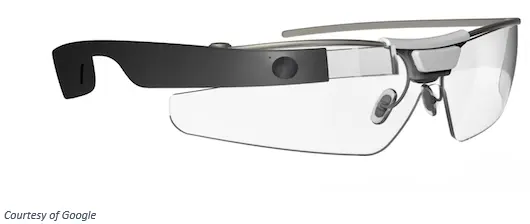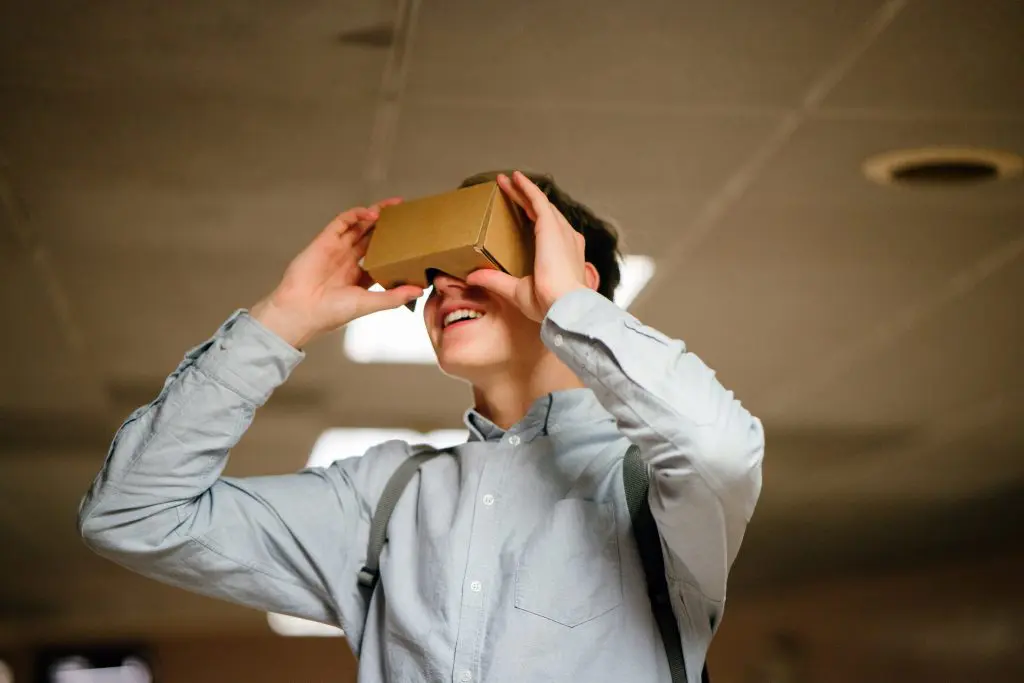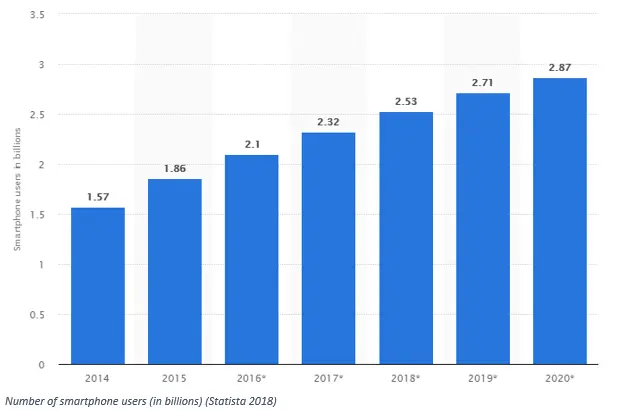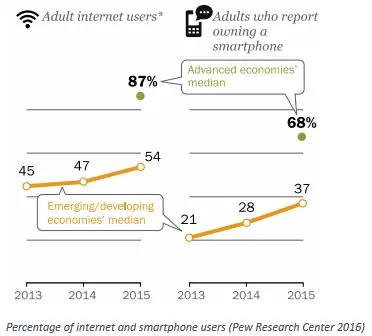THE FUTURE IS INSIDE YOUR POCKET
Virtual reality is a rapidly growing phenomenon and mostly we can thank smartphones for that. While virtual reality started with dedicated hardware, smartphones are taking over. In this article, we will briefly describe different types of virtual reality and discuss how smartphones can shape the future of virtual reality. Using smartphones as a tool, virtual reality can change the way people live, work and play.
Types of virtual environments
Virtual reality is a computer-generated environment that simulates an experience. Virtual reality environments can be seen on a scale based on the similarities to the physical reality (Thurman & Mattoon 1994).
“On the left end of the scale, virtual reality simulates or mimics real-world counterparts which correspond to natural laws. On the right side of the scale, virtual reality represents abstract ideas that are completely novel and may not even resemble the real world” (Thurman & Mattoon 1994:57)
Based on the techniques we currently have, this can be seen as follows:
On the left side of the scale you have the real environment: our world as we know it.
The centre of the scale is augmented reality, also known as AR. Augmented reality is a live view of the real environment, whose elements are adapted or augmented by computer-generated information which can be delivered through different senses. The overlay is created in such a way that it is perceived as an aspect of the real environment.
Virtual reality is an environment that simulates an experience. It is presented to our senses in such a way that it creates the feeling we are really there. Virtual reality submerges its users therefore in another world. We also call this immersive, as opposed to non-immersive when you observe a situation on a flat screen such as a television.
Augmented reality devices
Augmented reality can be created by using various devices. One of the first known device is the Google Glass.
The Google Glass is a pair of smart glasses. This is also called a head-mounted display which is shaped like eyeglasses. Data is projected on the glasses and therefore, it allows you to see data without looking away from your usual viewpoint. Microsoft Hololens and the new Magic Leap go further: they scan the environment to match perfectly data projected and the environment.
Another option is to use your smartphone as an augmented reality device. You can point the camera of your smartphone into the real world, and on your screen you will partly see the real world, but with an overlay of additional data.
Virtual reality devices
A virtual reality environment is usually displayed by the use of a head-mounted display: a headset with a small screen in front of the eyes. Depending on the type of equipment you use, you can look around in the artificial world, move around and interact with objects.
Most of the virtual reality devices require a powerful computer to generate the virtual environment. Examples of these are the Oculus Rift and the HTC Vive. Another option is to use your smartphone to power the headset. You just click your smartphone into the headset and you are ready to go. Examples of these types of headsets are the Samsung Gear VR and the Google Cardboard. A last option is a stand-alone headset which doesn’t require a smartphone or a computer, such as the Oculus Go which has been released this year. It’s an interesting solution if you need a dedicated, high-quality, portable device.
Google Cardboard
The benefits of using your smartphone to enter the virtual world
Using your smartphone to immerse yourself into virtual reality has numerous benefits. We will highlight a few:
Price
An Oculus Rift or an HTC Vive will easily cost you $400-$500, and you’ll also need a powerful computer to use the device. Purchasing a stand-alone headset costs at least $200. To use your smartphone, you could start by purchasing a Google Cardboard for only $2 or if you want some more features you could buy the Samsung Gear VR which costs $100. Assuming that you or your client already own(s) a smartphone, it’s a good deal.
Availability
Almost anyone has a smartphone, which makes virtual reality more accessible than ever. Smartphone usage is also expected to continue to grow (Gartner 2012):
The rising number of smartphones and the lower price of a virtual reality headset for your smartphone compared to desktop headsets makes virtual reality available for anyone.
Mobility
You can take your phone and portable VR headset with you, wherever you go. This allows you to show and experience virtual reality anywhere. Often you can download the virtual experience beforehand so you don’t even need internet at the location. Once you’re on site, you just launch the application and you’re ready to go.
Sharing
Since anyone who owns a smartphone can access virtual reality, you can also share virtual reality experiences and applications by email, text or in any other way. This is especially beneficial if you want to share your company’s custom-made experience with remote customers.
Marketing
Virtual reality is new, booming and interesting. While this is also the fact with non-mobile VR experiences, these aren’t easily displayed to your customers. Moreover, you can get a Google Cardboard personalized with your brand and give this to your customers. Because of the simplicity of a smartphone, it will also be easy for your customer to launch the experience independently. However, make sure you get your experience developed by a company with a lot of knowledge about VR.
Virtual reality for emerging economies
Emerging economies can benefit from virtual reality in many ways, but foremost to educate. As written in a previous article on our blog, virtual reality addresses mirror neurons if a procedure is filmed from the first point-of-view. While showing such footage in an immersive virtual reality environment, people can learn new actions rapidly and precisely.
Not only on a world scale, but also in emerging economies the use of smartphones (and internet) is rising. Much of this increase is coming from larger developing economies such as China, Brazil and Malaysia (Pew Research Center 2016).
This growing availability of smartphones opens up incredible possibilities for developing economies. Mostly it makes that learning new procedures, such as highly required surgical operations, can be done in a place where there is a lack of teachers. If the procedure is filmed in the right way, almost any manual knowledge can be transmitted. We should therefore keep investing in mobile virtual reality, to make education accessible to anyone.
Smartphones make virtual reality accessible to more and more people every day. It offers many benefits such as a lower price, mobility and the possibility to offer more educational facilities in emerging economies. Technological and pedagogical expertise is required to design virtual reality experiences. Revinax comes with this expertise and keeps a close eye on improvements in training techniques. We specialize in the development of videos for a virtual reality environment. We develop immersive tutorials for complex gestures in various fields, such as the medical domain, risk management and crafts. We use real-life, 3D video footage, filmed from a first point-of-view, in order to optimize the benefits of virtual reality. For more information on our virtual technology and applications, don’t hesitate to check our website or contact us.
References
Gartner. “Gartner Says Worldwide Smartphone Sales Soared in Fourth Quarter of 2011 With 47 Per Cent Growth.” Feb. 2012.
Pew Research Center, “Smartphone Ownership and Internet Usage Continues to Climb in Emerging Economies” Feb. 2016.
Statista, “Number of smartphone users worldwide from 2014 to 2020 (in billions)”, 2018, https://www.statista.com/statistics/330695/number-of-smartphone-users-worldwide/.
Thurman, Richard A., and Joseph S. Mattoon. “Virtual Reality: Toward Fundamental Improvements in Simulation-Based Training.” Educational Technology, vol. 34, no. 8, Oct. 1994, pp. 56–64.










